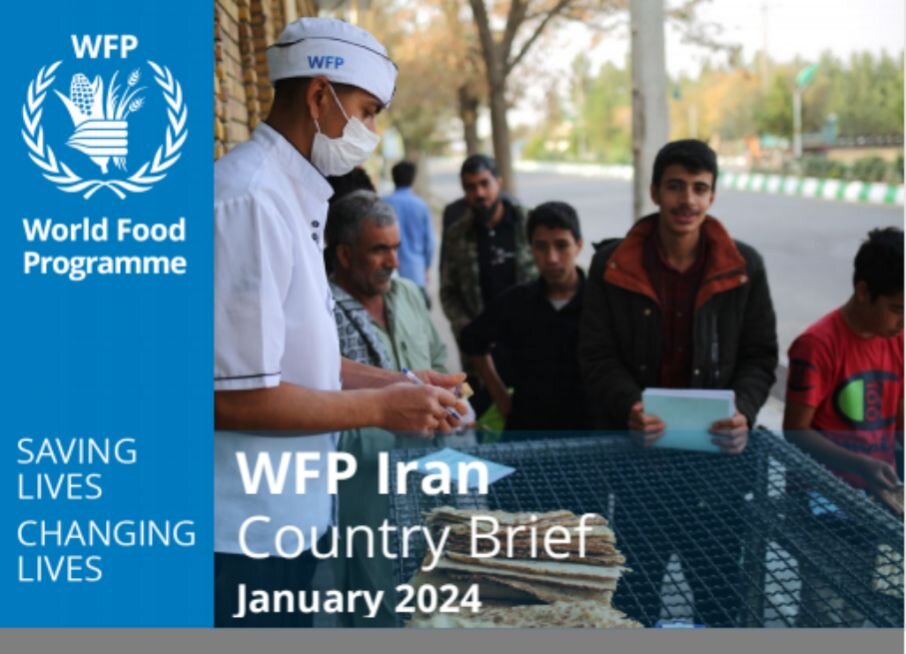WFP releases January report on Iran

TEHRAN - The World Food Program (WFP) has released a report, expounding on activities in Iran over the month of January.
In January, WFP food assistance reached 33,225 beneficiaries, which includes Afghan and Iraqi refugees.
Of this 28 percent were women, 29 percent were men, 21 percent were girls, and 22 percent were boys. Refugees are assisted with a staple food basket which includes fortified wheat flour (12 kg per person per month) and vegetable oil (900 ml per person per month), milk, a date bar, and biscuits.
In addition to this in-kind food assistance, WFP provides cash assistance to 7,325 Afghan and Iraqi refugee households each month.
In January, households headed by refugee men received Iranian Rials (IRR) 2 million (US$ 5.1, according to the UN Operational Rate) per person.
Households headed by refugee women received a slightly higher monthly cash allocation, amounting to IRR 2.5 million (US$ 6.3) per person due to limited access to working opportunities, leading to higher food insecurity.
To maintain beneficiaries’ purchasing power amid deteriorating economic conditions, since June 2023, WFP has increased its cash assistance to vulnerable refugee women and men facing serious risks over their food security and well-being.
In January, a total of 9,077 students and their teachers received snacks.
Also, WFP provided 2,726 refugee girls with a cash incentive of IRR 500,000 (US$ 1.2) transferred to their bank accounts.
This is a part of WFP Iran’s efforts to promote education for refugee girls by providing them with cash for each month of regular school attendance.
In January, WFP distributed wheat floor in 20 settlements so that refugees could have bread as their main food basket item.
The presence of bakeries in the settlements strengthens the resilience and self-reliance of refugees through reduced travel time and costs otherwise needed to buy bread outside the settlements and helps reduce friction between refugees and host communities.
In January, a total of 21 WFP-supported livelihood activities including welding, tailoring, baking, farming, bag making, and suit making, remained functional and sustained their operations supporting 351 refugees (58 percent women and 42 percent men).
Following WFP’s Disability Inclusion Workplan 2023, WFP implemented a pilot initiative in two settlements, Shahid Naseri of Markazi and Mohajerin of Semnan provinces, providing refugees with disabilities a monthly cash top-up of IRR 1 million (US$ 2.6) on top of their regular entitlement. In January, the program successfully reached 100 beneficiaries targeted for assistance.
Meanwhile, according to WFP’s 2022 report on Iran based on Interim Country Strategic Plan (2018-2023), Iran was one of the most affected countries by the COVID-19 pandemic.
While the pandemic gradually abated and restrictions were lifted by mid-2022, the country continued to struggle with its severe negative socio-economic impacts, the report said.
In mid-2022, the Government decided to cut subsidies from staple food items. As a result, the prices of meat and poultry, dairy products and cooking oil increased fourfold overnight.
Inflation and increased prices of basic food commodities combined with local currency devaluation and reduced job opportunities due to a stagnating economy have significantly reduced the purchasing power of vulnerable groups including refugees.
Against this backdrop and despite the tightening of trade restrictions and external barriers, WFP Iran succeeded in meeting its plan of supporting over 32,000 refugees living inside 20 settlements with unconditional food assistance through a combination of locally procured in-kind food and cash-based transfers.
MT/MG
Leave a Comment